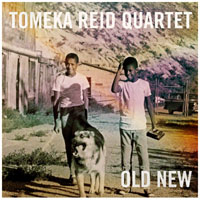Tomeka Reid Quartet • Old New
 he last five years have
seen an explosion of activity from cellist Tomeka Reid, starting even before she’d
relocated to New York from Chicago. She’d come up there in bands led by flutist
Nicole Mitchell and drummer Mike Reed, and steeped in the rich legacy of the improvising
composers co-op the AACM; nowadays she works with (among many others) Chicago-school
elders Anthony Braxton and Roscoe Mitchell. Reid also knows the rich if lesser-known
tradition of jazz string players like herself. While still in Chicago she assembled a
half-Windy, half-Apple quartet with Jason Roebke on bass and frequently paired New Yorkers
Tomas Fujiwara on drums and Mary Halvorson on guitar. The foursome had instant chemistry,
and Old New is a worthy sequel to their 2015 Thirsty Ear debut, Tomeka Reid
Quartet. he last five years have
seen an explosion of activity from cellist Tomeka Reid, starting even before she’d
relocated to New York from Chicago. She’d come up there in bands led by flutist
Nicole Mitchell and drummer Mike Reed, and steeped in the rich legacy of the improvising
composers co-op the AACM; nowadays she works with (among many others) Chicago-school
elders Anthony Braxton and Roscoe Mitchell. Reid also knows the rich if lesser-known
tradition of jazz string players like herself. While still in Chicago she assembled a
half-Windy, half-Apple quartet with Jason Roebke on bass and frequently paired New Yorkers
Tomas Fujiwara on drums and Mary Halvorson on guitar. The foursome had instant chemistry,
and Old New is a worthy sequel to their 2015 Thirsty Ear debut, Tomeka Reid
Quartet.
The crux of the band’s appeal is all that string-iness: the blend and interplay among bowed or plucked cello and bass and electric guitar. "Wabash Blues" (Reid’s own, not the 1921 tune) has a jumping beat and launches from two contrapuntal riffs, a descending one for bass and ascending one for merged guitar and bowed cello, the latter pair mixed in perfect balance. Reid’s single-note and double-stopped lines, and the physicality of her bowing, in her solo here or on "Old New," echo groundbreaking 1970s cellist Abdul Wadud’s bluesy grind, and the dervish momentum of the ICP Orchestra’s sawing wildman Tristan Honsinger. Guitarist Halvorson meanwhile sidesteps conventional blues figurations -- too obvious, not her style. "Sadie," written for Reid’s grandmother, is her pizzicato holiday, starting with all three strings in octaves or unison on the perky head. Soloing, Tomeka uses the hard plucky attack (and slightly pinched tone) jazz cellists often favor; it’s all about the front of the note, its placement in time, the exact spot where the swinging gets done. On this tune you can catch a whiff of Chico Hamilton’s puckish 1950s chamber jazz quintet, which had the same instrumentation (plus a horn). Reid writes enviably catchy melodies, so many she can be offhand with them. "Aug. 6" and "Edelin" start with open improvisations that gradually give way to the written material, but the tunes are so strong that their arrival feels like a step up. The improvising’s livelier when they play the tune first: it sharpens up everyone’s time. "Niki’s Bop" is propelled by Fujiwara’s martial snare and Roebke’s bass as bass drum, as arco cello and guitar play a stinging, hopscotching line in tight unison, spotlighting the bond between those melodists. Halvorson recently won a well-deserved MacArthur Fellowship. Like some other great guitarists (Bill Frisell, for one) she creates her own sound-world on the instrument. She combines adept use of pedals to slide a note out of pitch or time -- a striking, instantly recognizable, runaway whammy-bar effect -- and she’s great at balancing her live play and sampled/looped overlays, so you’re not always sure which line is which. That wizardry is coupled with a traditional jazz guitarist’s front-loaded attack, the better to swing or punch with -- I’m sensing a theme here -- and a bright tone. On the plaintive "RN," the backgrounds are filled in by either cello or guitar arpeggios; with those harp-like chords in the air, Halvorson’s sweep-strumming and use of delay unit in her solo create a striking myriad-harps, barbershop-mirrors effect. "Ballad" has another martial beat from drums,
but this one is more somber, as if an army were withdrawing after battle. Fujiwara is a
very good interactive drummer who can pop into (or out of) a groove with Roebke in a
blink, and can push without being overbearing, at a moderate volume realistically
rendered. Bass sound is fat but you can hear the wood in it, and also Roebke’s
propulsive attack. (He swings more overtly here than in other settings, and he’s a
fine 4/4 walker.) To document this music Reid has entrusted fellow musicians: bassist
Eivind Opsvik recorded them in Brooklyn, and trombonist Nick Broste (who’d recorded
their debut) mixed in Chicago. And noted, the balance between guitar and cello is perfect
(even as they’re lightly stereo-separated for textural clarity). Reverb: just enough.
Overall the sound gives the impression we’re listening to a band on the bandstand,
which is just how these four musicians play. |
